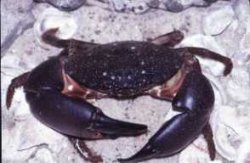Gulf Stone Crab (Menippe adina)

TPWD ©
- Description
- The stone crab's carapace (shell) is 3 to 3.5 inches (7.6 to 8.9 cm) long and about 4 inches (10 cm) wide. Stone crabs are brownish red with gray spots and tan underneath, and have large and unequally-sized pincers with black tips. Females have a larger carapace (the top outer shell), but males usually have larger claws than females.
- Life History
- Stone crabs prefer to feed on oysters and other small mollusks, polychaete worms, and other crustaceans. They will also occasionally eat seagrass and carrion (remains of dead animals). Predators that feed on stone crabs include horse conch, grouper, sea turtles, cobia, octopi, and humans.
Sexual maturity is reached at one year. Their long spawning season lasts all spring and summer, during which time females produce 500,000 to 1 million eggs. The larvae go through six stages in about 36 days before emerging as juvenile stone crabs. Their lifespan is seven to eight years.
The male stone crab must wait for the female to shed her exoskeleton before they can mate. After mating, the male will stay to help protect the female for several hours to several days. The female will spawn four to six times each season. Adult stone crabs make burrows in mud or sand below the low tide line, lying in wait for prey.
The stone crab loses its limbs easily to escape from predators or tight spaces, but their limbs will grow back. When a claw is broken in the right place, the wound will quickly heal itself and very little blood is lost. If, however, the claw is broken in the wrong place, more blood is lost and the crab's chances of survival are much lower. It only takes about one year for the claw to grow back to its normal size. Each time the crab molts its exoskeleton, the new claw grows larger.
The larger of the two claws is called the "crusher claw". The smaller claw is called the "pincer claw". If the larger crusher claw is on the right side of the crab's body, the crab is "right handed". If the crusher claw is on the left side of the crab's body, it is "left handed". Since crabs' eyes are on stalks, they can see 360°. A large crab claw can weigh up to half a pound. - Habitat
- Stone crabs prefer bottoms of bays, oyster reefs and rock jetties where they can burrow or find refuge from predators. Juveniles do not usually dig burrows, but instead hide among rocks or in seagrass beds.
- Distribution
- Stone crabs can be found along the Gulf Coast.
- How To Eat
- The stone crab has gained in popularity as a seafood delicacy in Texas and the commercial harvest has increased since 1984. This crab lives around rocky areas or oyster reefs and burrows into the sand. It is dark brownish-red with gray interspersed. Claws are hinged, very dark, and banded with red and yellow. All its legs are used for walking, and it has very strong pinchers used to crush oysters. Stone crabs are fished near jetties, oyster reefs or other rocky areas just as for blue crabs. Stone crabs have small bodies and only the claws are eaten. To be kept, claws must be two and one-half inches long, measured from the tips of the immovable finger to the first joint. Only one legal size claw may be removed and then the crab must be returned immediately to the water. The claws are prepared in the same manner as blue crab claws.
- Other
- Stone crabs have huge, tan, black-tipped claws. These bulky claws are strong enough to crush an oyster shell, and make these crabs valuable for their meat. Many people prefer to eat stone crab claws instead of blue crab claws. The stone crab's meat is supposed to taste like lobster. Because their claws can be regenerated, most states require that only one claw be removed and the crab be returned to the water. This way, over-harvesting of the species is prevented.